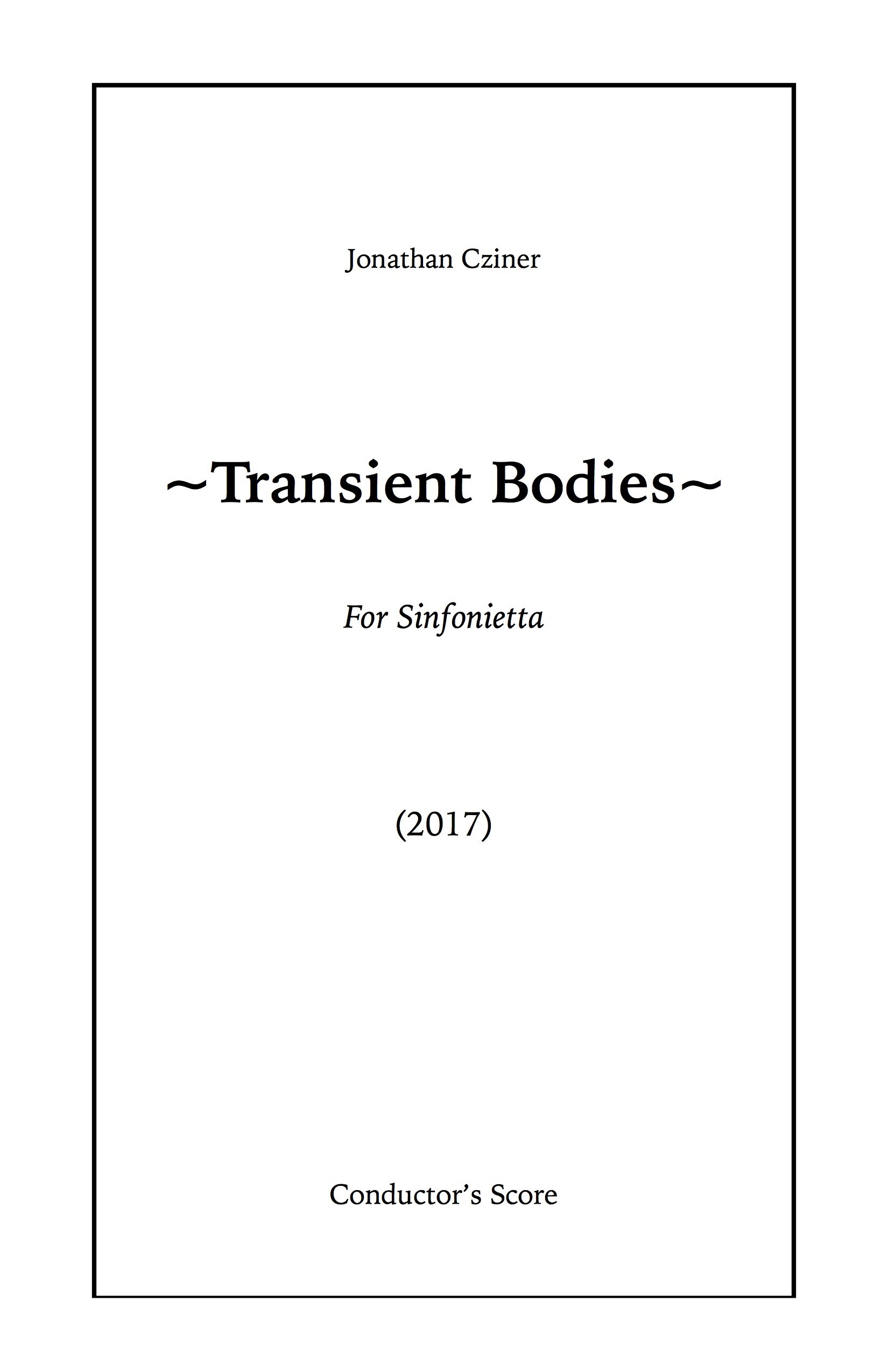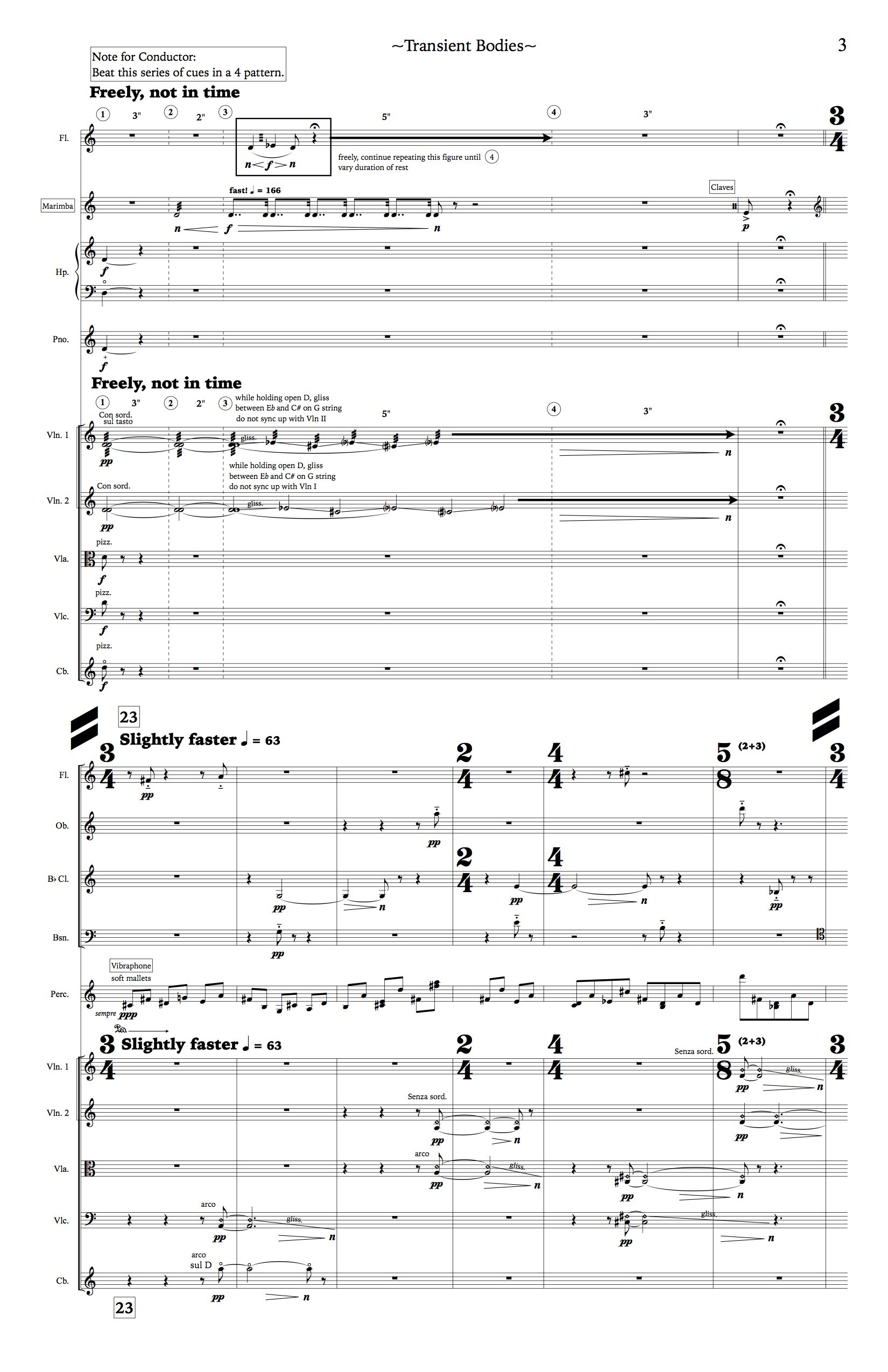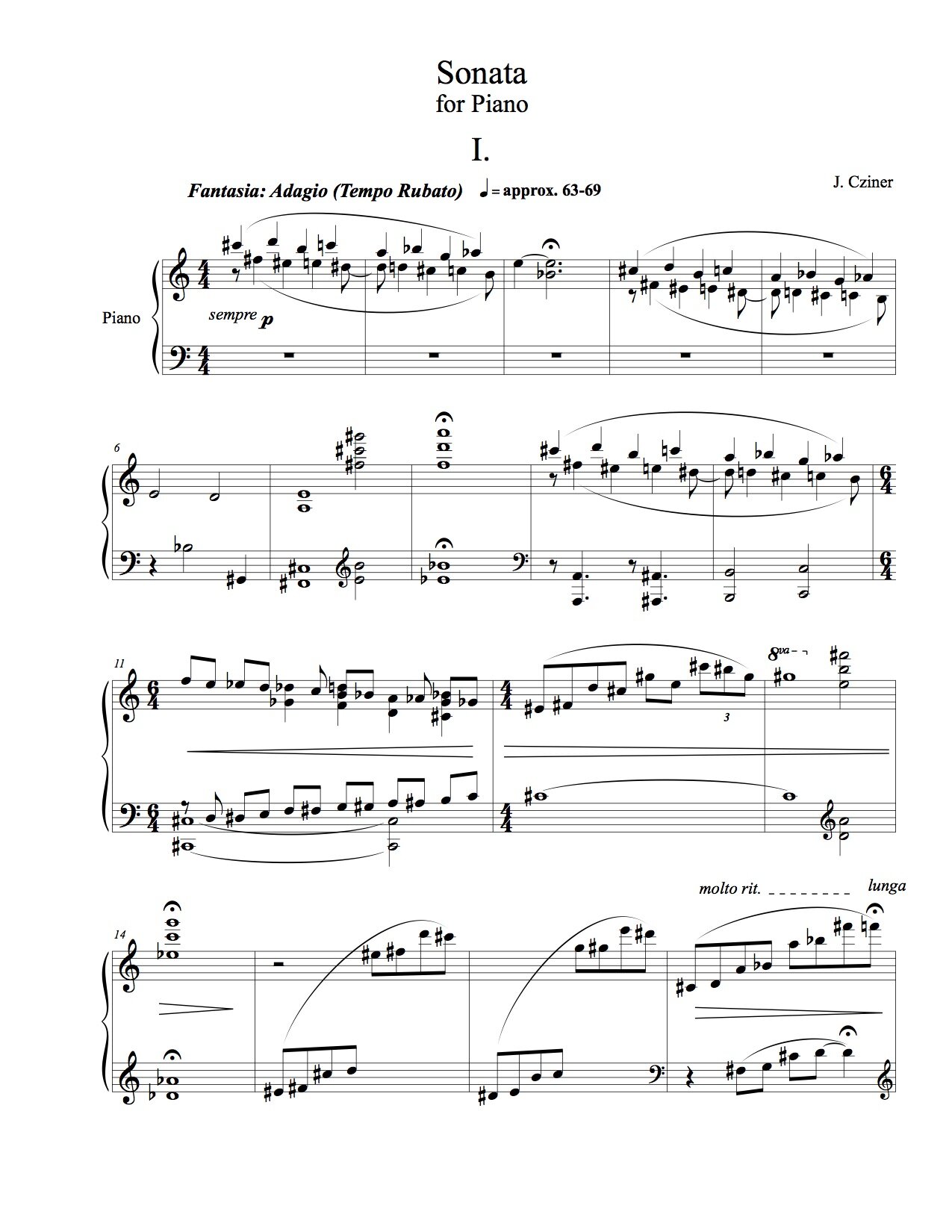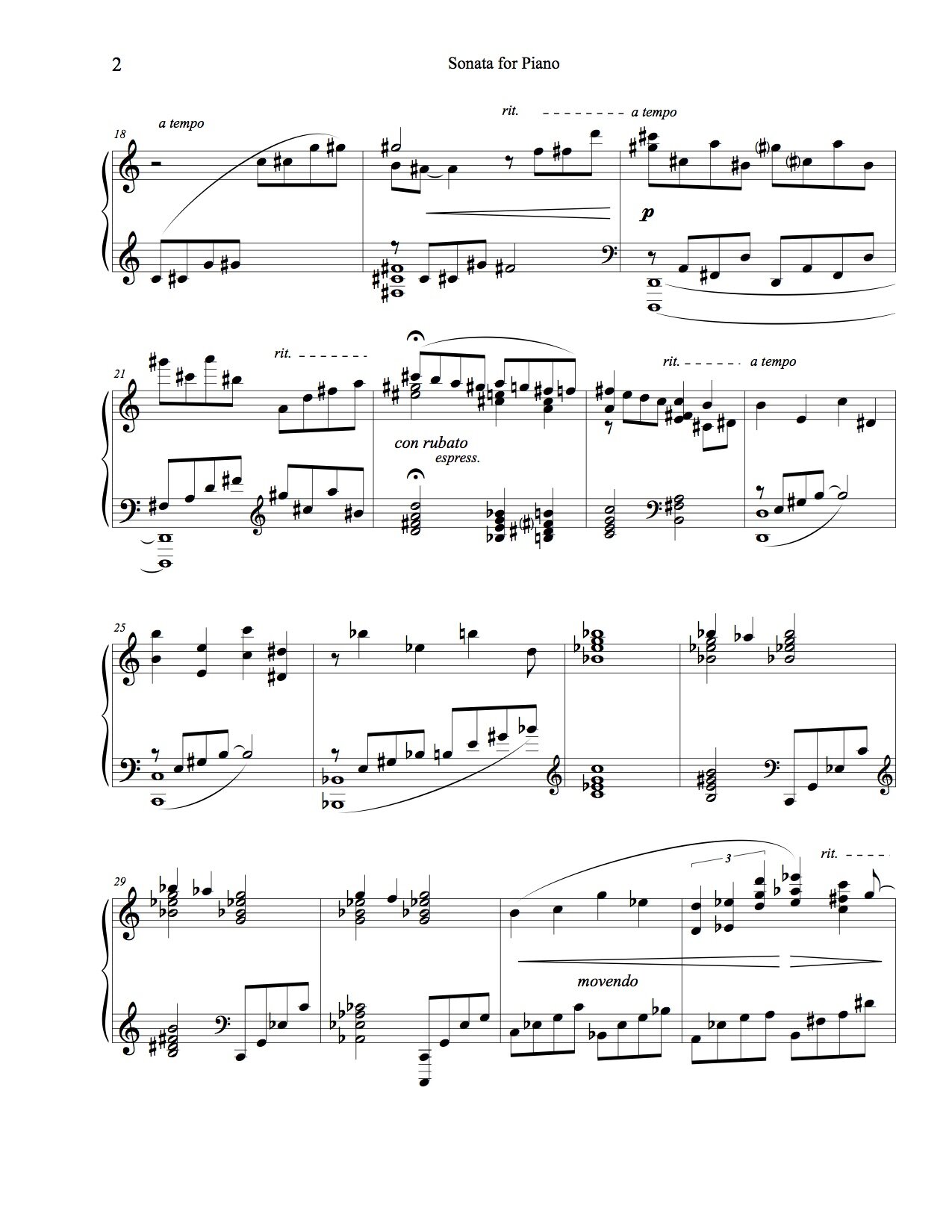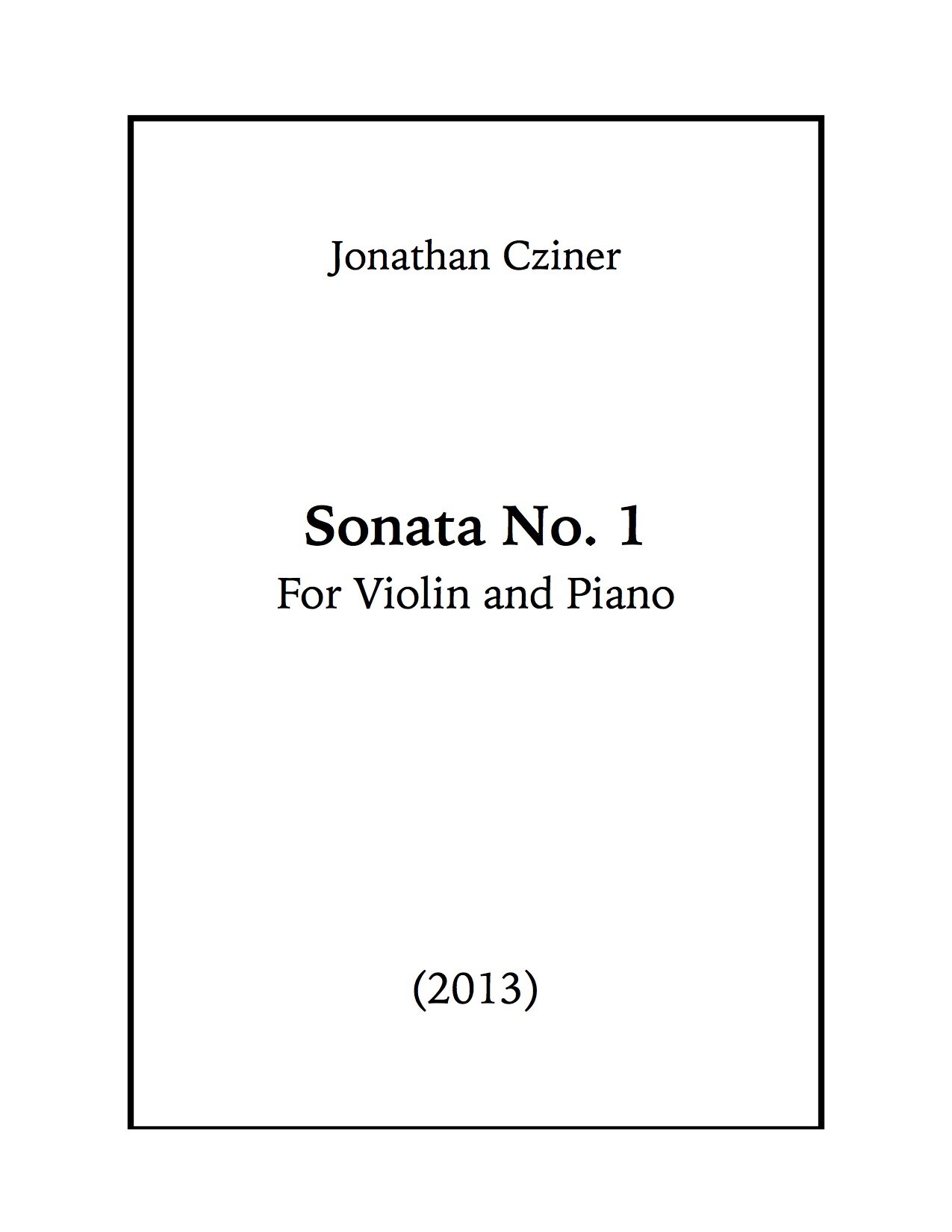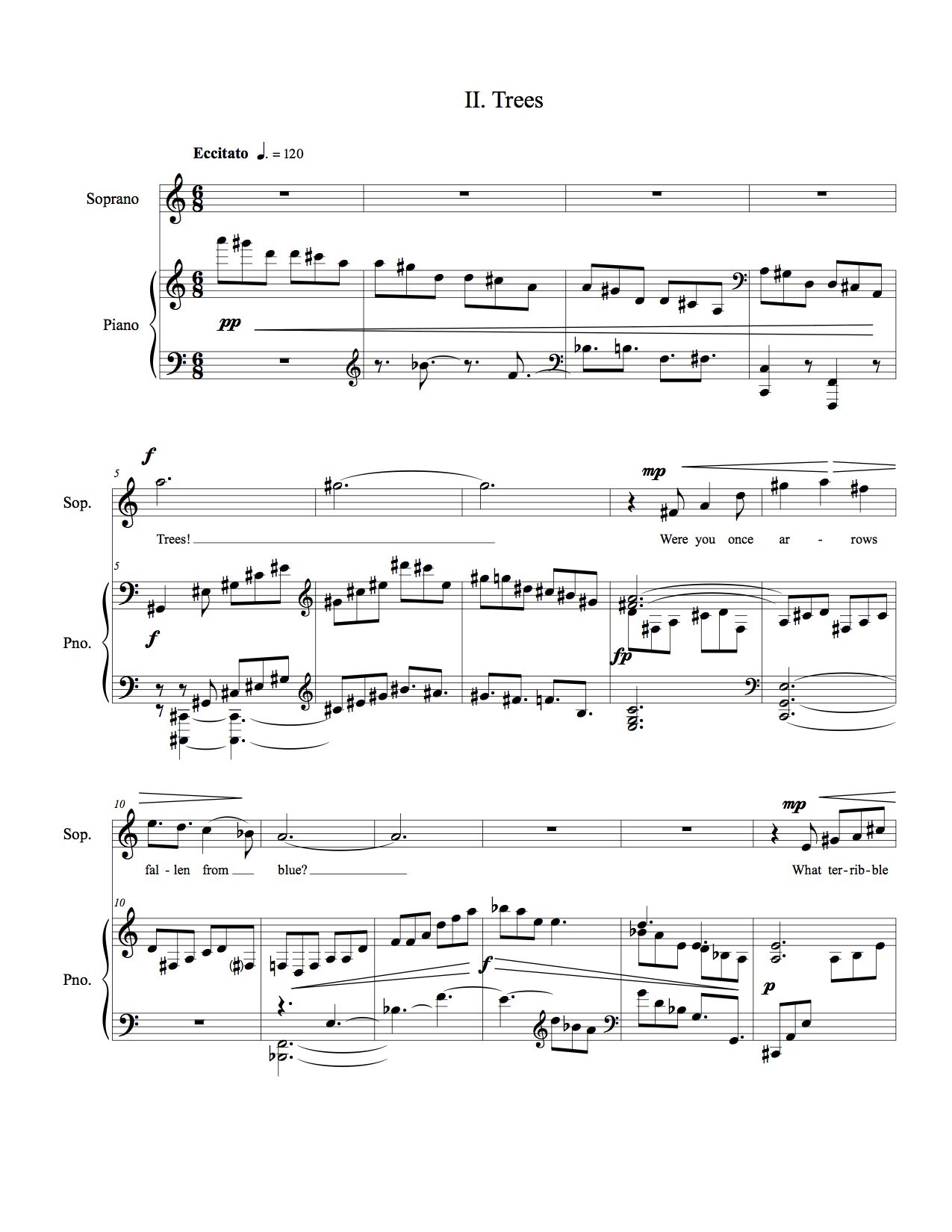Nifrach
(2023)
Commissioned by the Illinois Philharmonic Orchestra
Duration: 11:00
Instrumentation: String Orchestra (minimum string count 10.10.8.6.4)
Chamber Version: String Octet (4 vln. 2 vla. 2 vc.)
First Performance: May 13, 2023 - Illinois Philharmonic Orchestra, Stilian Kirov, conductor.
Subsequent Performances: August 6, 2024 - Charles Ives Music Festival, Jacob Joyce, conductor.
Version for String Octet. Jeremias Sergiani-Velázquez, Julia Choi, Beryl Diamond Chacon, George Meyer; violins. Jacob Shack, Leah Ferguson; violas. Ariana Nelson, Mitch Lyon; cellos. Jacob Joyce, conductor.
about Nifrach
Tzaddikim katamar, nifrach. Righteous ones, like the palm tree, we will blossom.— Adapted from Psalm 92
This piece is dedicated to my nana, Linda Blum, in memory of my papa, Manfred Blum, who passed away in the summer of 2021. At a young age, Papa Fred was forced to flee Nazi Germany with his mother and brother to meet his father in America, who preceded them to help make the arduous trip across the Atlantic Ocean possible. Though he lost most of his extended family in the Holocaust and never returned to Germany, Papa Fred was one of many displaced Jews who worked hard in the United States to create a successful and fulfilling life. The title of the piece, Nifrach, translates from Hebrew to “we will blossom.” The metaphor of a flower in bloom serves as an important concept for the work. Musically a delicate opening gesture played by a single violin germinates over time into lush textures and emotional landscapes incorporating the entire string orchestra. On a more personal level, my grandparents surname—Blum —is Ashkenazi German-Yiddish for “flower.” I feel his story is but one example of the perseverance and resolve of the Jewish people, who have overcome many tribulations and have cultivated and blossomed wherever they found themselves in the world. This piece honors those who have planted the seeds that future generations will grow.
Rear-view
(2022)
Commissioned by the Illinois Philharmonic Orchestra
Duration: 11:00
Instrumentation: 2222. 4331. -timp. -perc.(2) -hp. -strings
First Performance: February 25, 2023 - Illinois Philharmonic Orchestra, Stilian Kirov, conductor.
Subsequent Performances: November 17 & 18, 2023 - Milwaukee Symphony Orchestra, Ruth Reinhardt, conductor.
about Rear-view
“Objects in mirror are closer than they appear.”
Rear-view is based on this perplexing sentence fragment commonly found on the rear-view mirror of one’s car. A series of musical ideas (objects) are presented in the following sequence: a chord progression, a melody, and an accompaniment. Then, in mirror, these objects are turned around and played backward, albeit slightly truncated. We get a closer look at these objects as they are developed in various ways, and finally at the end of the piece, they appear simultaneously in a rousing conclusion. On a more personal level, this same idea is reflected in my memories of old road trips, which conjure feelings of fondness but also nostalgia. Each road trip is filled with a series of memories that morph over time and together form the entirety of a grand adventure.
Celestial Symphony
(2022)
Commissioned by the Illinois Philharmonic Orchestra
Duration: 20:00
Instrumentation: 2222. 2200. -timp. -strings
First Performance: November 13, 2022 - Illinois Philharmonic Orchestra, Stilian Kirov, conductor.
Movements:
- Nebulae
- Heaven and Earth
- sternenzelt
about Celestial Symphony
Celestial Symphony takes as its primary inspiration two things I love dearly: the music of Beethoven and the mystery and beauty of the cosmos. Though seemingly two very different things, I find that they share quite a bit in common. The connection is most apparent in the Ode to Joy of Beethoven's 9th symphony with the word sternenzelt, which roughly translates to "star-tent" or "starry canopy." In the Ode to Joy, the text and music evokes a sense of spiritual wonder referring to the benevolent heavenly being who dwells above such an expanse. I experienced a sternenzelt first hand in the Colorado Rocky Mountains of Colorado in summer 2016. The beauty and profundity of this moment was the impetus for composing this symphony.
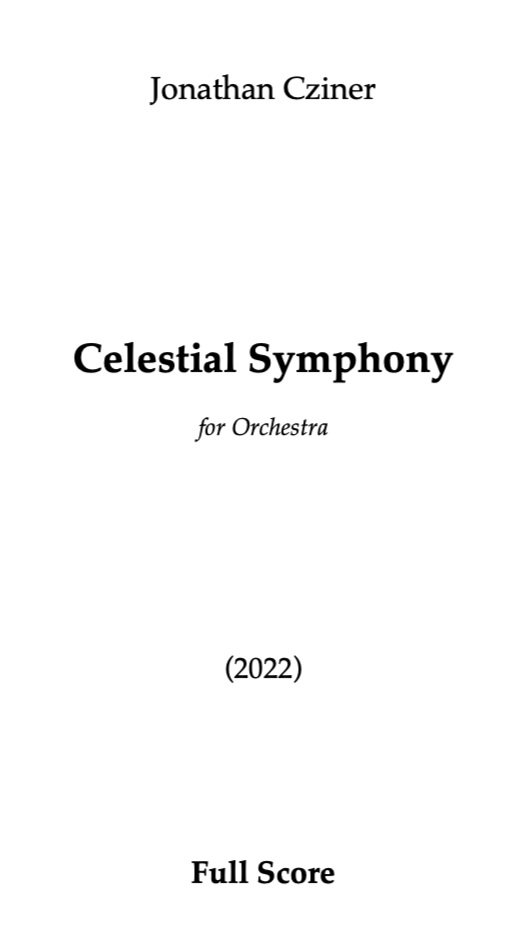
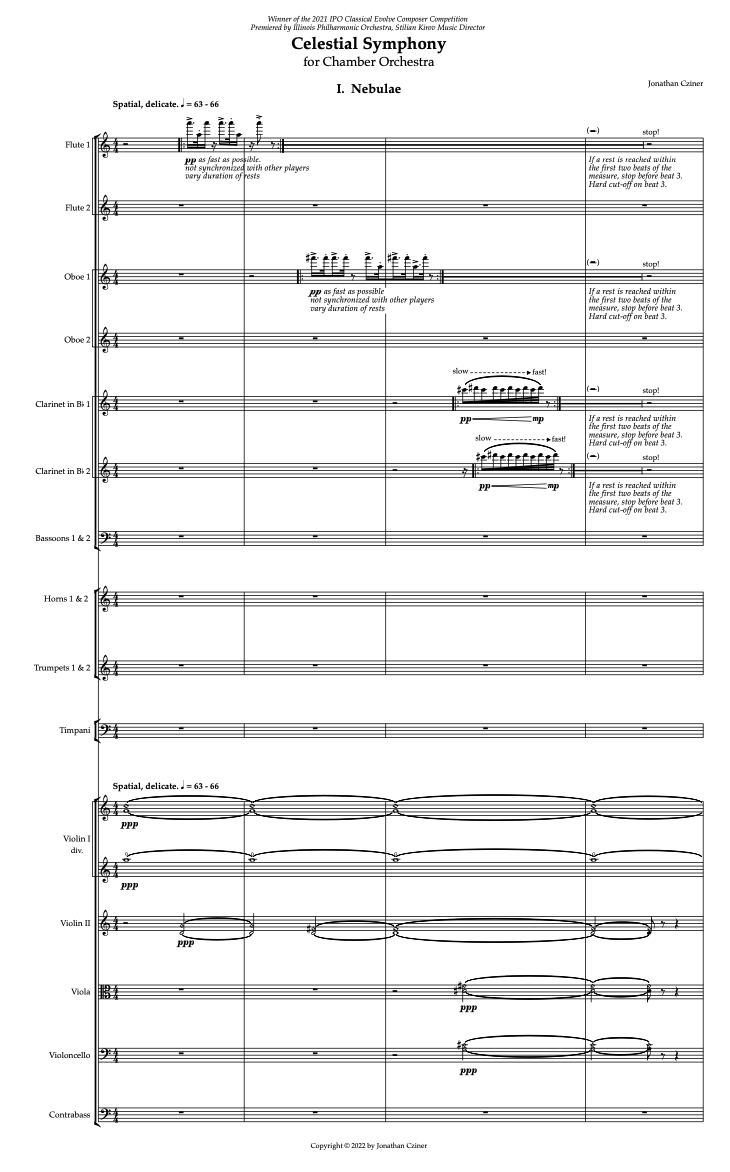
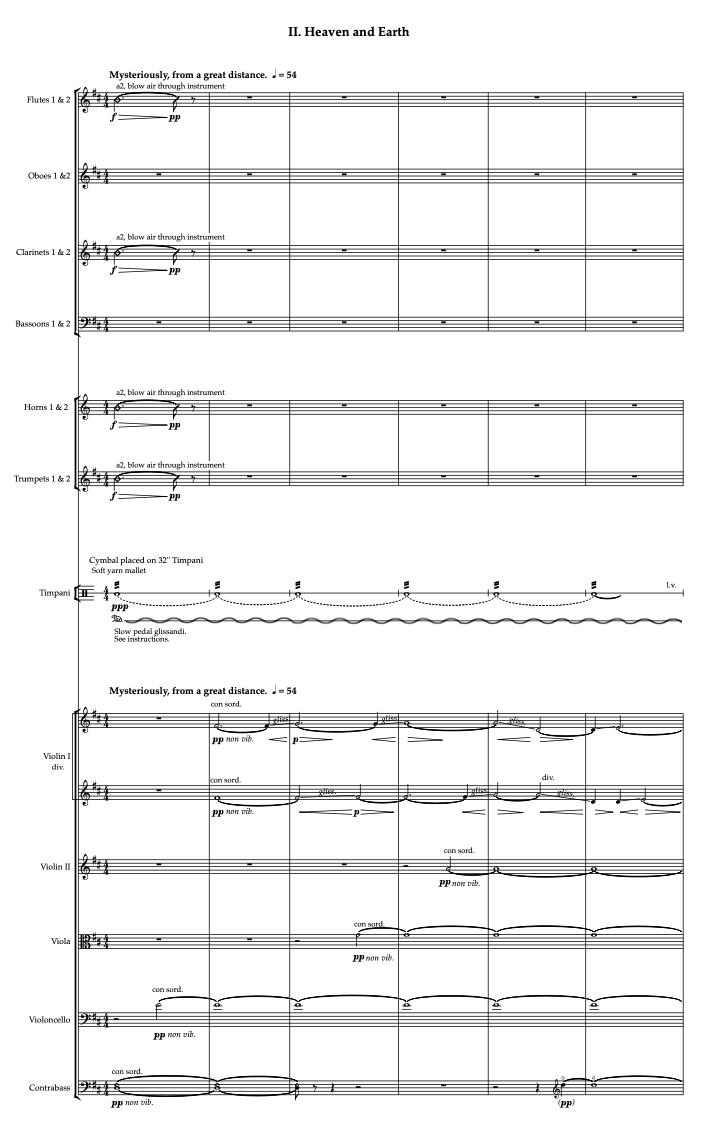

The journey of Celestial Symphony is that from the purely scientific and observational view of the cosmos from Earth to a more spiritual and mystical one. During my compositional process, there were many advances in space imagery, giving us incredible, detailed visuals of black holes, nebulae, and more. The first movement, Nebulae, imagines many of these images musically, with luminous and motion-filled "clouds" in different families of the orchestra highlighted against various harmonic backgrounds.
Heaven and Earth, the shortest movement of the piece, presents a dichotomy between the celestial and the terrestrial. Within lush cluster harmonies in the strings, a solo bassoon introduces a quote from the finale of Beethoven’s 9th symphony — the sacred. This quote is then twisted and disfigured and the once sublime melody becomes the basis for a short, prickly fugal episodes — the worldly. To me, this movement symbolizes the way our modern society sometimes manipulates sacred texts as a means for political and economic gain. This movement is supplemented with various extended timpani techniques including the use of a suspended cymbal and pitched crotales placed upon the timpani, creating a kind of “halo effect.”
Sternenzelt, the final movement, revisits music from the previous movements while introducing new material of its own, and in a true Beethovenian sense, ascends from death and despair to light and hope. Episodic in nature, a dramatic introduction gives way to a jagged Danse Macabre, distinguished by multiple rhapsodic concertmaster solos. Death does not have the final word in this symphony however, and the uplifting end of the symphony evokes the visual and emotional experience gazing into a starry expanse — a sternenzelt. Wondrous.... celestial... mysterious.... existential... eternal.
Ruach (and Other Delights)
(2020)
Co-commissioned by the New York Youth Symphony and Interlochen Arts Center
Duration: 15:00
Instrumentation: 3333. 4331. -timp. -perc.(3) -hp. -cel. -strings
First Performance: March 13, 2022 — New York Youth Symphony; Michael Repper, conductor. (Carnegie Hall; NY, NY)
Subsequent Performances:
- May 14, 2023 - Greater Dallas Youth Orchestra; Jonathan Cziner, conductor. (Meyerson Symphony Center; Dallas, TX)
- TBA - Interlochen
about Ruach (and Other Delights)
Ruach (and Other Delights) was composed during the spring and summer months of 2020. In an attempt to find some light amidst all of the darkness in the world, I began reading Ross Gay’s The Book of Delights, a series of essayettes in which he poetically documented one thing that delighted him every day for an entire year. Moved by this idea, as well as the essays themselves, I decided to document some of the things that delighted me during my quarantine in Dallas, TX with my girlfriend (now wife!) Emily Levin and our two dogs Charlie and JoJo.
The piece consists of a series of 12 short musical episodes or miniatures played without pause, always connected by or derived from the large 12 note chord that unfolds at the beginning of the work. I chose the Hebrew word Ruach (spirit/breath/wind) because to me it expresses an omnipresent force that is the source of and activates the twelve delightful episodes, uniting them throughout the work. The general form is that of an arch: Slow - Fast - Slow - Fast - Slow, but more specifically the titles of each of the connected miniatures that appear in the score are as follows:
Fairy Lights (m. 16)
Fairy Lights of a Different Color (m. 30)
The Blue Bar (m. 36)
Paws (m. 74)
Lift off from 72258 (m. 117)
More Paws (m. 144)
Final Descent into 75203 (m. 159)
Whipple Scrumptious Fudgemallow Delight (m. 192) Zooming (m. 230)
Microburst (m. 301)
Midnight Walks (m. 321)
New Beginnings (m. 337)
I will be the first to admit that I often find myself losing faith, and more generally, I sometimes tend to see the negatives rather than the positives, especially in this troubling age. However, it is in the darkest of times that we must not forget all of the little delights in life. Perhaps a higher power is somehow guiding each of us down our own paths toward these special people, places, and things, and it is my sincere hope that the music inspires, you, the listener, to ponder this great mystery.
Resonant Bells
(2018)
Duration: 12:00
Instrumentation: 3333. 4331. timp. -perc(3) -harp -cel -strings
First Performance: July 14, 2018 — NJSO, David Robertson, conductor (Princeton, NJ).
Subsequent Performances:
- January 2019 - Minnesota Orchestra, Osmo Vänskä
- Summer 2020 - Grant Park Music Festival (cancelled due to COVID)
- November 2020 - Portland Symphony Orchestra (cancelled due to COVID)
Awards:
- Winner of the 2018 William Schuman Prize (BMI)
- Winner of the 2018 Palmer Dixon Prize (Juilliard)
- Selected for the Minnesota Orchestra Composer Institute
- Selected for the New Jersey Symphony Orchestra Cone Composition Institute
about Resonant Bells
"...Yet the ear it fully knows,
By the twanging,
And the clanging,
How the danger ebbs and flows:
Yet the ear distinctly tells,
In the jangling,
And the wrangling,
How the danger sinks and swells,
By the sinking or the swelling in the anger of the bells..."
We live in unsettling times. Bells by nature can be advisory or prophetic, and in a world that is wracked with turbulence, the words of Edgar Allan Poe's "The Bells" ring true. Resonant Bells captures the essence of alarm bells, and the implication of warning that echoes in the ears of those who hear them.
The piece opens mysteriously, with the announcement of a repeating note rhythmic motto. After a vertical unfolding of harmony and an expansion of the repeating note figure, the music explodes, introducing us to premonitory tolling bells made up of an amalgamation of vibraphone, chimes, glockenspiel, and celesta. A dramatic, possibly even hoeroic lyrical passage builds the work to its first climax, which is thwarted by the bells, this time orchestrated in winds and brass in addition to the original percussion. After the dust settles, a transitional passage comprised of meandering woodwind solos is interspersed with a new iteration of the original repeating note motto. The music pushes forward into a dizzying scherzando section, whch is at times playful, and at other times demonic. After much whirling and twirling, the chaos erupts at last into an apocalyptic reprise of the lyrical passage now intertwined with the dizzying scherzando material. Any hope of altering course is once and for all derailed by the tolling of the bells, now in the entire orchestra. The piece closes with an elegiac chamber-like setting of the lyrical passage, and in the final moments, returns us to the very opening, as if to remind us that "we were warned."
Resonant Bells was composed November 2017 to February 2018 and lasts approximately 12 minutes in duration.
Transient Bodies
(2017)
Commissioned by the New Juilliard Ensemble
Duration: 11:00
Instrumentation: 1111. 1110. -perc(1) -harp -pno -strings:11111)
First Performance: April 4, 2017 – New Juilliard Ensemble, Joel Sachs, conductor
Alice Tully Hall, New York, NY.
about Transient Bodies
I was born with an astigmatism in my left eye, a fairly common defect caused by an irregular curvature of the cornea, which results in distorted images as light rays are prevented from meeting at a common focus. I also sustained severe trauma to my right eye in a rather damaging sports accident at a young age. Since this accident, I have experienced what are known as entoptic phenomena—visual effects whose source is within the eye itself. Most people do, or will, experience various types of these effects in their lifetime.
Without my glasses to correct my astigmatism, the world is like a glowing impressionistic painting. Overall outlines, shapes, and colors are favored over finer details. At the same time, my painting is complete with its fair share of entoptic phenomena: ever shifting shadows and flashers, transient bodies floating and sparkling around randomly, unendingly.
Though these imperfections make me aware of my mortality and fragile nature, there is something extraordinarily beautiful about them. Because entoptic images are caused by factors within the observer’s own eye, the observer cannot share a direct and specific view of this phenomenon with others. Only I can experience and see my own personal entoptic world, just as you are the only one who can experience yours.
Transient Bodies was commissioned by Joel Sachs and the New Juilliard Ensemble and received its premiere on April 4, 2017 in Alice Tully Hall. It is approximately 10 minutes in duration.
Solaris
(2023)
Commissioned by the Illinois Philharmonic Orchestra
Duration: 14:00
Instrumentation: 2222. 4331. -timp. -perc.(2) -cel. -solo vln. -strings
Chamber Version: Violin & Piano
First Performance: October 14, 2023 - Stella Chen, violin. Illinois Philharmonic Orchestra, Stilian Kirov, conductor.
Subsequent Performances:
- October 5, 2024 - Stella Chen, violin. Bakersfield Symphony Orchestra - Stilian Kirov, conductor.
- January 21, 2025 - Stella Chen, violin; Gilles Vonsattel, piano (Montreal, Quebec)
- Feburary 2, 2025 - Stella Chen, violin; Gilles Vonsattel, piano (Stanford, CA)
about Solaris
I’ve always had a bit of an infatuation with the cosmos. Over the last few years, I’ve composed pieces which take various elements of the heavens as inspiration (including my first symphony, Celestial Symphony, which the IPO premiered in November of 2022). Solaris, which in Latin means “of the sun,” was composed for my friend Stella Chen, whose name in Latin means “star.” Rather than a full length concerto, I wanted to write a piece that highlights her dynamic and versatile abilities as a violinist, as well as her intelligence and bubbly personality.
The piece opens with a mysterious introduction featuring the solo violin accompanied by crystalline orchestral effects in the celesta and percussion that introduce many of the motivic and thematic material in the piece. The music then segues into a violin cadenza, which builds in tension and momentum to reach the piece’s first climax — marked “Bright!” — which to me represents looking directly into the sun. Jazz-like chords in the brass support rapid scalar passages in the solo violin, which launch into the faster section of the work: a juxtaposition of soaring lyrical lines and violin virtuosity. This section dies away into a reprise of the opening, this time cast primarily in the orchestra. After this orchestral interlude, the violin reappears, leading to a grand climax and a dazzlingly fast coda.
flowers of fire
(2018)
Written for the Juilliard Orchestra
Duration: 18:00
Instrumentation: 2222. 4331. timp. -perc(3) -harp -cel - solo soprano -strings
Chamber Version: Fl. Cl. Hn. Tpt. Vln. Vc. Perc(1) & Harp
First Performance: February 28, 2019 — Kathleen O’Mara, soprano, The Juilliard Orchestra, Jeffery Milarsky, conductor. Alice Tully Hall, New York, NY.
about flowers of fire
In 1914, American poet Amy Lowell read her poem, The Bombardment, to an audience of about 400 people in Boston. Composer Carl Engel, a friend of Lowell's, reproduced the sounds of falling bombs with a bass drum. The visceral experience of the drum's vibrations paralleled the vivid and horrifying imagery in Lowell's war poem, which told the stories of various citizens in an unnamed European city during an air raid. Flowers of Fire uses Lowell's poem to capture the devastation of loss in all its forms -- not just of life, but also of treasured family heirlooms, artistic dreams, and childhood innocense and safety. As the listeners and performers grapple with these manifestations of loss, the bass drum mercilessly bombards our ears, just as it did at the original reading.
While this piece commemorates the 100 year anniversary of the end of World War I, it also sheds light on our inability to learn from the past. In light of recent events, in particular the massacre at the Tree of Life Synagogue in Pittsburgh, I chose the Jewish prayer Oseh Shalom to close the work. 100 years later, we are still dealing with horrific acts of violence in our time and our world. This prayer's eternal plea for peace is a message that I hope will resonante with all who listen.
Texts
Excerpts from The Bombardment
Amy Lowell (1874 -1925)
Slowly, without force, the rain drops into the city. It stops a moment on the carved head of Saint John, then slides on again, slipping and trickling over his stone cloak. It splashes from the lead conduit of a gargoyle, and falls from it in turmoil on the stones in the Cathedral square. Where are the people, and why does the fretted steeple sweep about in the sky? (Boom!*) Silence. Ripples and mutters. (Boom!)
The room is damp, but warm. Little flashes swarm about from the firelight. The lusters of the chandelier are bright, and clusters of rubies leap in the bohemian glasses on the 'etagere'. Her hands are restless, but the white masses of her hair are quite still. (Boom!) The vibration shatters a glass on the etagere'. It lies there, formless and glowing, with all its crimson gleams flowing red. A thin bell-note pricks through the silence. A door creaks. The old lady speaks: "Victor, clear away that broken glass. One hundred years ago my father brought it —“ (Boom!) The room shakes. Another goblet shivers and breaks. (Boom!)
It rustles at the window-pane, the smooth, streaming rain. Inside is his candle, his table, his ink, his pen, and his dreams. He is thinking, and the walls are pierced with beams of sunshine. A fountain tosses itself up at the blue sky, and through the spattered water in the basin he can see copper carp, lazily floating among cold leaves. A wind-harp in a cedar-tree grieves and whispers, and words blow into his brain, bubbled, iridescent, shooting up like flowers of fire, higher and higher. (Boom!) The flame-flowers snap on their slender stems. The fountain rears up in long broken spears of disheveled water and flattens into the earth. And there is only the room, the table, the candle, and the sliding rain. (Boom!)
A child wakes and is afraid, and weeps in the darkness. "Mother, where are you?” The child screams at the yellow petalled flower flickering at the window. The little red lips of flame creep along the ceiling beams. (Boom!)
The Cathedral is a torch, and the houses next to it begin to scorch. (Boom!) The bohemian glass on the `etagere' is no longer there. (Boom!) The poet rushes into the street, and the rain wraps him in a sheet of silver. The city burns. Quivering, spearing, thrusting, lapping, streaming, run the flames. Now the streets are swarming with people. They seek shelter and crowd into the cellars. They shout and call, and over all, slowly and without force, the rain drops into the city. (Boom!) And the steeple crashes down among the people. (Boom!) The water rushes along the gutters. The fire roars and mutters. (Boom!)
Oseh Shalom
Prayer for Peace
Oseh shalom bimromav, Hu yaaseh shalom aleinu, v’al kol Yisrael, v’al kol yoshvei teveil. V’imru: Amen
String Quartet
(2021)
Commissioned by the Carpe Diem String Quartet
Duration: 15:00
Instrumentation: String Quartet
First Performances: February 10 & 11, 2024 - Carpe Diem String Quartet. Columbus, OH.
about String Quartet
My first String Quartet is in five movements, each a vignette about dissimilar things that are held together musically. The first, Pingala’s Mirror, is named after Acharya Pingala, an ancient Indian poet and mathematician who is known for being the first to experiment with what we know as the Fibonacci numbers, an additive sequence in which each number is the sum of the preceding two. Contrary to popular belief, the Fibonacci sequence was not discovered by Leonardo of Pisa — known by the name Fibonacci — but rather by Pingala, as early as the 2nd century BCE. This movement presents an additive series of pitches, beginning on the note E, which is then spun around and presented backward, like a mirror. At the center of this mirror is a new theme, played in violin harmonics, that reoccurs throughout the work in different iterations.
The remaining four movements, which are all played without pause, begin with the Nocturne. This movement introduces a new motif: cascading scales, and functions as an introduction for the third movement. Heartbeat is the musical core of the piece, containing material from the other movements and is dedicated to my dad, who is a cardiologist. The pizzicati chords at the beginning of this movement are indeed a reference to the sound of a beating heart. The fourth movement Aubade opens with a grand restatement of first movement material and to me represents a blazing sunrise. The second half of the movement, which references the Nocturne, introduces the final movement entitled Whitewater. The cascading scales, which are ever present in this movement, shift harmonically, gain in speed and intensity, and are vigorously overlapped resulting in a sound that reminds me of my thrilling (and terrifying!) experience white-water-rafting in the Grand Canyon as a boy with my family. I want to thank my good friend Ariana Nelson and the Carpe Diem String Quartet for asking me to participate in the quartet’s 15 year anniversary commissioning project. With such an incredible catalogue of string quartets, I have until this point shied away from composing one myself, but I’m grateful for the chance to finally rip off the proverbial band-aid.A Household of Three
(2021)
Commissioned by Fine Arts Chamber Players
Duration: 15:00
Instrumentation: Violin, Cello, & Piano
First Performance: Maria Schleuning, violin; Jolyon Pegis, cello; Benjamin Loeb, piano. Sammons Center - Dallas, TX.
Subsequent Performances: George Meyer, violin; Julian Schwarz, cello; Marika Bournaki, piano. Charles Ives Music Festival - Danbury, CT.
about A Household of Three
There was a fateful moment in history when the 20 year old Johannes Brahms knocked on the door of Robert and Clara Schumann’s Düsseldorf home in the fall of 1853. After Brahms arrived unannounced holding only a letter of introduction from violinist Joseph Joachim, the following months saw these three artistic giants living under the same chaotic roof. While Brahms pledged himself to Robert’s teachings and worked tireless on his craft, he also became infatuated with Clara. Meanwhile, Robert wrote an article hailing the unknown young Brahms as "the Chosen One,” and worked hard to get Brahms’ early works published even as Brahms was falling deeply for his wife. By the next February, Robert’s mental health had declined so rapidly, he had attempted suicide by jumping into the Rhine River. Clara was torn between her loving husband, and the young, handsome, and talented Brahms who was clearly interested in her as shown in their letters. Needless to say, to be a fly on the wall of the Schumann’s house in the winter of 1853-54 would have been interesting to say the least.As an homage to the great works of these three composers, my piece is constructed in a large modified Sonata-Form, and alludes and/or quotes pieces that were written around the time they were all living under the same roof. While the piece opens with a disfigured quotation of the opening of Robert’s A Minor Concerto, the slower middle section (marked Serene, glacial in the score) is comprised of a quote of the solo cello theme from the second movement of Clara’s Piano Concerto. This quotation of Clara’s concerto sets off a spiral of various quotations of works by Brahms and the two Schumanns—often at the same time—, which creates a cacophonous effect of different familiar musics being played in different tempi and different keys simultaneously. (Listen for Brahms’ First Piano Trio, First Piano Concerto, and Double Concerto; Robert’s Piano Concerto and Ghost Variations, and Clara’s Romances Op. 21).
While Brahms and Robert are primarily remembered as composers, and Clara remembered as a brilliant pianist, the laters compositional ability has finally received some well-deserved recognition. Clara was the central figure of this trio of great artists. She was absolutely both Robert’s and Johannes’ muse but not in the “romantic” way that we think of, but rather it was her through her musical ability and ingenuity that inspired both mens compositions. Clara encouraged Robert to compose his A Minor Piano Concerto after several failed attempts. Robert not only took the key Clara used for her own concerto but also its form. Robert’s second and third movement are played without pause just as Clara had done almost ten years earlier. Brahms, who was perhaps one of the most self deprecating composers ever, was constantly seeking Clara’s approval and musical advice for each of his masterworks. The greatest moments of clarity and calmness in my piece are connected to allusions or quotations of Clara’s music as above all, she was the guiding light, musically and emotionally, for both of these men.
Toward a Brilliant Light
(2015)
Written for the Atlantic Music Festival
Duration: 8:00
Instrumentation: Fl. Cl.(=B. Cl.) Vln. Vc. Pno. Mixed Perc.
First Performance: July 15, 2016 — Atlantic Music Festival Contemporary Ensemble. Colby College, Watertown, ME.
about Toward a Brilliant Light
While nearing completion of Toward a Brilliant Light I came upon this quotation of Leonard Bernstein that seemed to say everything that needed to be said:
"We must never forget that music is movement, always going somewhere, shifting and changing, and flowing, from one note to another; and that movement can tell us more about the way we feel than a million words can.”The original goal was to write a piece that started in a very static place and ended in a very lively one. Subconsciously however, the music I was writing was also taking on a more emotionally charged role than originally planned. As the music changes it seems to move from a very dark place emotionally to a very light place. To me, the title does not refer to anything specific. The ‘brilliant light,’ so to speak, functions as a metaphor to the gratifying emotional place that the music strives towards. At the same time, the ending of the piece undoubtedly has a definite luster about it which certainly could be taken more literally.
Music for the Temple
(2019)
Commissioned by Astral Artists for harpist Emily Levin
Duration: 7:00
Instrumentation: Harp
First Performance: March 2022 — Emily Levin, harp. Philadelphia, PA
Subsequent Performances:
- February 2024 - Emily Levin, harp. Dallas, TX.
about Music for the Temple
When Emily and I visited the Guggenheim Museum’s exhibition of the works of Hilma af Klint, we were both taken aback. Neither of us had ever seen anything quite like these paintings and we were struck by their beautiful colors and mathematical complexities. They were somehow simultaneously luscious and plain; ecstatically emotional and yet particularly calculated. We were immediately compelled to work together on a project that was inspired by this artist and her artwork.
The piece is constructed in the same manner of af Klints works: in a series of numbered chapters that are each derived in some way from the variations that came before it. Here there are 22 of these “micro-variations” each related to the first variation the series, which presents 12 pitches in order of growing intervallic relationships. In this way the entirety of the piece is connected but, as in the series of af Klint, in abstract ways. There is no traditional form, but rather certain elements are highlighted and reimagined, transforming into almost unrecognizable varieties.
af Klint was a spiritualist and was famously inspired to create many of her paintings by spirits referred to as “The High Masters.” She was assigned by the High Masters to create the paintings for the "Temple" – however she never understood what this "Temple" referred to. The title Music for the Temple is a direct reference to this and similarly, I’m not quite sure what the “Temple” is myself. Perhaps in my case, it is simply a concert hall — our musical shrines, where we pilgrimage to hear music. Whatever it may be, the overall character of my piece is one of mystery and deep spirituality, questioning the meaning of things, and finding beauty in the chaos of our world.
Echoes of Youth
(2019)
Commissioned by Steven Masi
Duration: 12:00
Instrumentation: Piano
about Echoes of Youth
- Romance
- Intermezzo — Frei aber Froh
- Ballade
- Intermezzo — Frei aber Einsam
Echoes of Youth was commissiond by Steven Masi as a companion piece to Johannes Brahms’s Sechs Klavierstück, Op. 118. These pieces show Brahms at his most personal and introspective — at times extremely tender, while other times brooding or even grim. An overarching theme in Op. 118 (as well as Op. 116, 117 and 119) is a feeling of nostalgia, wistful remembrances of a time come and gone.
I wanted my piece to have a similar nostalgic quality, as an homage to Brahms and also to pay tribute to the musical world Brahms left at the time of his death in 1897. There are slight hints at works of Debussy, Ravel, Scriabin, and Schoenberg, composers whom Brahms was aware of and who made him question his position in music history.
The two intermezzi have titles referring to Brahms’ own motto “frei aber froh” (free but happy) which was a reference to his friend Joseph Joachim, whose self-proclaimed motto was “frei aber einsam” (free but lonely). In spite of Brahms's claim, I have ended my piece with “frei aber einsam”--not a reflection on Joachim, but rather how I believe Brahms came to view himself, as a lifelong bachelor and one of the last “protectors” of tonality.
7 Character Pieces
(2018)
Commissioned by Edoardo Turbil
Duration: 14:00
Instrumentation: Piano
First Performance: January 8, 2019 — Edoardo Turbil, piano. Accademia Di Musica, Pinerolo, Italy.
About 7 Character Pieces
- interStellar
- Toccatina
- Mahleriana
- A Song Without Words
- Prelude and Fugue
- Willpower
- Pezzo Capriccioso
These 7 Character Pieces were composed for Edoardo Turbil in the summer of 2018. After composing Resonant Bells, a dark and brooding work for large orchestral forces, I wanted to write something that was entirely the opposite — something light and optimistic. I took inspiration in capturing the personalities of my colleagues in the DMA program at Juilliard. Each piece is dedicated to one of my friends, including the last piece which is dedicated to Edoardo himself.
The pieces try to capture the essence of the person, or in some cases, focus on incorporating music they enjoy writing or playing. All of the pieces are individualistic and could be played in any order or subset, provided that the Pezzo Capriccioso is performed last as it is the only piece that recycles material from some of the other pieces.
Fantasy Chorale
(2017)
Commissioned by the American Guild of Organists for Colin MacKnight
Duration: 9:00
Instrumentation: Organ
First Performance: November 5, 2017 — Colin MacKnight, organ. St. Thomas 5th Avenue Church, New York, NY.
about Fantasy Chorale
I have always been fascinated by the history and majesty of the organ. With its immense size and power, the possibilities are endless. I wanted to write a piece that paid homage to the rich history of organ music, but in my own 21st century American language.
The piece is structured in four main sections, marked Introduction, Chorale, Scherzo, and Finale. The Introduction, while quite short, is important nonetheless as it introduces the main musical ideas and presents the main crux of the piece: a battle between the keys D-flat and C. After an ambiguous opening, the piece attempts to blossom into D-flat Major foreshadowing the Chorale; however, a “fate“ motto stalls this attempt, and the introduction closes mysteriously.
The chorale grows out of almost nothing. Two voices turn into three, three into four, and so on, until the final version brings in the all the voices in full harmony. The “fate“ motto interrupts this ever-growing bliss and the music spirals out of control directly into the meandering and mischievous Scherzo. At the end of the section we hear the chaotic scherzo material over the grand Chorale theme, which is again interrupted by “fate.”
In the Finale, the “fate“ motto completely takes over the music. The very end of the piece pits D-flat Major against C Minor with simultaneous chords in both tonalities, however, it is C minor that wins out in the end, and the hope of a reprise of the blissful Chorale ends in tragedy.
...comes the light
(2017)
Commissioned by Emily Levin for her debut album, Something Borrowed
Duration: 5:00
Instrumentation: Harp
First Performance: September 19, 2017 — Emily Levin, harp. Le Poison Rouge, New York, NY.
about ...comes the light
In this piece I wanted to personify a timid, childlike character who is at first lonely and lost. The seedlings of a dream for better times attempt to break through this gloomy soil. Eventually, after a few attempts, the seed begins to bloom and the dream begins to take flight. By the end of the piece the character's dream has fully blossomed, and the opening material, now transformed, represents comfort and warmth.
4 Character Pieces
(2015)
Duration: 14:00
Instrumentation: Piano
First Performance: December 7, 2015 — Adam Rothenberg, piano. Paul Hall, The Juilliard School, New York, NY.
about 4 Character Pieces
- Live
- Elegy
- Mr. Isaac's Art
- Her Fervent Gaze
These 4 character pieces were composed at various crisis moments in my life during the past 2 years. Live in January of 2014. Elegy and Mr. Isaacs' Art in July of 2014, and Her Fervent Gaze almost a year later in the summer of 2015. Though each piece is quite short I feel very close personal attachments with the subjects of each of these character pieces. While the first three represent actual people, the final piece depicts an idea or fantasy of someone. I’d rather not say who in particular these pieces are about, but I will say that they deal with lost and unrequited love, death, close bonds of friendship and comic relief in difficult times, and the idea of finding love again respectively.
Sonata for Piano
(2011)
Duration: 13:00
Instrumentation: Piano
about Sonata for Piano
- Fantasia Adagio (Tempo Rubato)
- Presto Furioso
Ancient Voices
(2022)
Commissioned by Alexander Kienle
Duration: 10:00
Instrumentation: Horn & Harp
First Performance: April 2024 — Alexander Kienle, horn; Emily Levin, harp. Dallas, TX.
about Ancient Voices
Program Notes by Laurie Schulman
Cziner's inspiration for Ancient Voices comes from two ancient instruments of the Jewish tradition - the shofar and the kinnor. The shofar is a trumpet-like instrument, traditionally made from a ram's horn. It was used by ancient Jews in religious ceremonies and as a battle signal. Today it is sounded during the Jewish High Holidays of Rosh Hashanah and Yom Kippur. According to the Encyclopedia Brittanica:
The shofar has four sounds: tekiah, a long, loud blast calling people to attention; shevarim, three broken blows which sound like crying; teruah, nine or more staccato rings serving as a wakeup call to the new year; and tekiah gedolah, a great blast played at the end of the Rosh Hashanah service.
The kinnor, an ancient type of lyre, is thought to have been the instrument of King David. In both the Greek Old Testament and the Latin Bible, it is translated as kithara, and it is the first instrument to be mentioned in the Hebrew Bible. In modern Hebrew, the term kinnor refers to a violin.
The catalyst for Ancient Voices was Alexander Kienle, who had asked Cziner to write a piece for him before the pandemic. "It was definitely a challenge to write," Cziner allows. "I tried a lot of new things especially in the horn writing, including the use of natural harmonic rips and stopped horn. Using natural harmonics emulates the sound of the shofar, which does not have valves or keys. The result can be notes not perfectly in tune, but they create the effect of something older, less refind than modern instrument."
The harp part also entails some unorthodox and extended techniques. "I couldn't resist using the human voice a little bit, as a nod to my title," Cziner explains. "When Emily sings into the back of the instrument, the harp acts as a natural amplifier, and also adds a ghostly sheen to the sound. After Alex plays his 'shofar blasts,' it will sound as if somehow it is still audible far off in the distance."
Cziner's form is influenced by the four blasts of the shofar described avoce. "Ancient Voices' opening sectio cycles through all four of those blasts," he explains, "culminating in a tekiah gedolah. [Later] is an extended scherzo-like passage based on the teruah blasts. The very end is the tekiah gedolah."
Cziner's 10-minute score incorporates some passages of aleatory [randomness] in which he has left the duration of execution up to each performer. "These sections should feel free and improvisatory," he says. This part of the piece feels like a study, an experiment to me. I trust the performers to be flexible and to bring a little something extra to the notes on the page."
Wanderlust
(2020)
Duration: 7:00
Instrumentation: Harp and Guitar
First Performance: November 2021. Davin Levin Duo. Kosciouskco Foundation.
Subsequent Performances: (All by the Davin, Levin Duo)
- November 11, 2022 — Davin & Levin, Greenbay WI
- October 16, 2022 — Davin & Levin, Camp Hill, PA
- October 15, 2022 — Davin & Levin, Summit, NJ
- June 3, 2022 — Davin & Levin, Cleveland, OH
- May 15, 2022 — Davin & Levin, Macon, GA
- February 6, 2022 — Davin & Levin, Westcliffe, CO
- February 5, 2022 — Davin & Levin, Denver, CO
about Wanderlust
Wanderlust was composed in the spring of 2020 during the early days of the COVID-19 pandemic. The music of Franz Schubert, filled with it’s nostalgic melodies and poignant harmonies, was swirling around in my brain. In particular, the romantic symbol of the wanderer, present in many of his iconic lieder, really spoke to me at a time when I was quarantined from the rest of the world. My piece takes Schubert’s Wandererfantasie, a work based on his own lied Der Wanderer, as a jumping off point. My work utilizes and interweaves some of the musical elements of Schubert’s masterpiece including the dactyl (long - short - short) rhythmic figure that opens the Fantasie. I’ve always associated the word “wanderlust” with my wife Emily Levin who delights in packing her suitcase and traveling all over the world. This piece is dedicated to her with love, and with gratitude to her duo partner and our friend Colin Davin, who helped me significantly through my first attempt at writing for the guitar.
still, moving
(2019)
Commissioned by Julian Schwarz and Marika Bournaki
Duration: 9:00
Instrumentation: Cello and Piano
First Performance: August 30, 2019 – Julian Schwarz, cello & Marika Bournaki,* piano*. Bargemusic, Brooklyn, NY
about still, moving
The title refers to things that are either man-made or occur in nature that appear to be “still” (stationary, solid, or static) but are actually constantly moving. Each variation is titled after a specific occurrence, and while some are literal and pictorial, others are more philosophical.
Musically, this premise is embodied by the roles of the two instruments. The piano remains fairly “still,” in that it adheres relatively closely to the original theme, while the cello embellishes and introduces new content throughout the piece.
The variations are as followed:
- Moving
- Clouds
- Tides
- Waterfalls
- Skylines
- Love
- In Orbit
- Still
Still, moving was composed for Julian Schwarz and Marika Bournaki and was premiered by the duo on August 30, 2019 at Bargemusic. The piece lasts 9 minutes in duration.
Once New
(2017)
Duration: 20:00
Instrumentation: Viola and Harp
First Performance: November 14, 2017 – Emily Levin, harp & Jacob Shack, viola.
The Kosciuszko Foundation, New York, NY.
about Once New
- Come
- Stay
- Change (attacca)
- Fly
- Remember
Since before I can remember, I have always loved Simon and Garfunkel. Their music is rich with beautiful lyricism and fragile simplicity, and at the same time filled with complex emotions. Their music immediately conjures up the bittersweet feeling of nostalgia, especially in one of my favorite tunes, “April, Come She Will”. The song deals with the trials and tribulations of a relationship over time: newfound love, the good times as well as the bad, and eventually the reality of the end of a relationship. The haunting melody (sung by Art Garfunkel), and the beautiful lyrics (written by Paul Simon, based on an English nursery rhyme) have always moved me deeply. This piece is my own take on the song, which was originally written for acoustic guitar and voice. Because of this, I felt that viola and harp would work perfectly for this piece. The harp easily replaces the guitar, and the earthy and melancholic quality of the viola matches the range of the human voice. My original plan was to write six movements corresponding to the original nursery rhyme, but in order to avoid two slow and reflective movements at the end of the work, I composed five, combining the last two lines of the rhyme into one movement.
The first movement, Come, is an inviting spring-like allegro. It introduces the main motives in the work, including an idée fixe— a three-note figure derived from the Paul Simon song. Despite its overt merriment, the movement’s middle section and climax foreshadow the darkness to come by highlighting the other main motive: a descending minor second. Stay, the second movement, is a long instrumental aria for the viola. This movement culminates in an affirmative and grandiose restatement of the opening music from the first movement.
The third movement is the most complex of the five movements, though it opens in a rather trite and playful manner. Over time however, this music warps into a grotesque version of itself. Episodic and turbulent, this movement leads directly into the fourth movement, entitled Fly, a dizzying scherzo. From this point onward, the idée fixe completely disappears from the music, as the minor second motive takes over.
The finale is comprised of two parts. The first is a funeral march, which references the penultimate lyric: “August, die she must.” The second half includes a succession of flashbacks through the previous movements, which finally ends with a harassing minor 9th interval in the viola, defeating the opening chord of the work played in the harp.
Responses
(2016)
Commissioned by Ariana Nelson
Duration: 11:00
Instrumentation: Cello and Piano
First Performance: April 17, 2017 – Ariana Nelson, cello & Adam Rothenberg, piano.
Paul Hall, The Juilliard School, New York, NY.
About Responses:
- Seethe
- Breathe
Responses was written for cellist Ariana Nelson and was completed in mid November 2016. Two starkly contrasting movements present different responses to the same raw musical material.
The first movement, Seethe, molds the material into savage running 16th notes in the cello. Mixed in with these more violent passages are moments of high register tremolando effects alternating with low register pizzicato glissandi, which offer an eerie counterpart to the opening gesture. The middle of the first movement contains the only respite, which foreshadows the more expansive sound-world of the second movement, entitled Breathe.
This movement takes this same musical material as the first and transforms it into an aimless and ambiguous running 8th note line in the piano. As a listener, this line is difficult to follow or trace, but as we get lost in it, it becomes oddly comforting.
Personally, this piece was my response to the build up to the 2016 Presidential election. The music is filled with harmonic and rhythmic tension that reflected the looming anxiety I was experiencing during the weeks prior.
Sonata No. 2 for Violin and Piano
(2016)
Commissioned by the Charles Ives Concert Series for Hannah Ji and Robert Fleitz
Duration: 20:00
Instrumentation: Violin and Piano
First Performance: August 11 2016 — Hannah Ji, violin & Robert Fleitz, piano.
Marian Anderson Recital Hall, Danbury, CT
about the Sonata No. 2
This piece is my journey into the world of the “American” Violin Sonata. My Sonata stems very much from tradition (i.e. the movement titles: Double Variations, Scherzo, Aria, Finale) but like many American composers who followed a traditional approach, the music also contains contemporary characteristics and sound-worlds that embody much of 20th and 21st century American music. Each movement is loosely inspired by different American composers, and the overall emotional trajectory of the piece expresses a spirit of optimism, which I perceive to be a feeling that, even in the most difficult of times, we always continue to strive for as Americans.I. The Double Variations are not based on two differentiating themes, but rather the idea of opposites: fast and slow, extroverted and introspective, or, if you will, left and right. There are four variations each opening with fast, finger-twisting passages, which are then followed by more static and restrained lyrical passages. The construction of this movement subtly predicts the form of the rest of the piece, and thus functions as a prelude of sorts.
II. The Scherzo is the most neoclassical of the movements, and emits an aura of being clearly rooted in tradition but “on the wrong notes.” This movement is full of twists and turns and even, maybe, some laughs.
III. The main melodic material of the Aria is derived from the opening theme of Robert Beaser’s Violin Sonata; the pitches are different but the shape of the line is very similar. The movement opens with the violin playing this lonesome melody, and eventually the piano joins, accompanying with soft harp-like chords. After a short piano solo, the music becomes more agitated and builds to a soaring, affirmative climax, and by the end, this movement brings us out of the ambiguity of the first two movements into a place of quiet contentment.
IV. The Finale continues the positivity of the Aria and the once enigmatic material of the first movement is now fully transformed. The music from the first movement returns in the middle of this movement only to be once and for all overwhelmed by the rush of the newly transformed material and the piece comes to a jubilant and triumphant conclusion.
Sonata No. 1 for Violin and Piano
(2011-2012)
Duration: 16:00
Instrumentation: Violin and Piano
about the Sonata No. 1
The Sonata No. 1 was begun in late 2011 and not completed until February of 2013. The piece originated as a two movement work, however after the premiere of these two movements in 2012, I realized that another movement was needed to precede them in order to properly present the musical material of the piece.The first movement is episodic, and begins with a passionate melody in the violin which, out of nowhere, erupts into a grotesque march. This march settles into a short scherzando section which foreshadows material that will appear in the final movement. After a reprise of the opening theme the music calms into a new section. It’s “lyric” theme, which is hinted at earlier in the movement, appears in different forms throughout the work in each of the movements. The movement closes with the march theme, this time presented in a fugal setting.
The second movement, begins with a mysterious version of the “lyric” theme. This movement elaborates on and varies much of the material from the first movement and leads directly into the third movement, which begins with a bang.
The finale is a dizzying moto perpetuo. In the middle we finally hear the “lyric” theme in its full soaring glory, but the bliss is short lived. Insanity takes over once more, and the piece ends in a fury.
The Nature of Loss
(2014)
Duration: 8:00
Instrumentation: Soprano and Piano
First Performance: November 5, 2014 — Kresely Figueroa, soprano & Joseph Yungen, piano.
Paul Hall, The Juilliard School - New York, NY
about The Nature of Loss
While many songs about summer are jovial and life affirming in tone, these songs certainly are not. The genesis of these three songs was originally meant to serve as studies for a large orchestral work, which utilizes a text by Pablo Neruda. I wanted to practice my vocal writing before setting off to write an important and emotional piece. As I came upon these texts by Federico Garcia Lorca these pieces quickly became more than just studies and more like legitimate personal statements. The texts resonated deeply with me for different reasons.
The first text makes reference to olive trees, which took on a metaphorical significance to me, and the song places the listener in a gloomy atmosphere. The second poem attempts to bring us out of the gloom until the last line is spoken: "Trees! Will your tough roots meet my heart in the soil?" This existential passage brings us back to the depths from which we began. The final song is a lament showing the protagonist doing the only thing there is left to do: cry. All of the songs are united in one common theme... Immersed in nature, I escaped from the city to the solitude of the beautiful countryside, while composing this set of songs.
Text by Frederico Garcia Lorca (1898-1936):
I. Landscape
The field of olive trees
opens and folds like a fan.
Above the olive grove
is a sunken sky
and a dark rain of cold bright stars.
Reeds and half-light tremble
on the banks of the river.
The gray air curls.
The olive trees are charged with shouts.
A flock of captive birds move their long, long tails
in the gloom.
II. Trees
Trees!
Were you once arrows
fallen from blue?
What terrible warriors
cast you down? Was it the stars?
Your music springs from the soul of birds,
from the eyes of God,
from perfect passion.
Trees!
Will your tough roots
know my heart in the soil?
III. Leave Me Here Crying
The scream leaves on the wind
Its shadow of cypress.
Leave me here in these fields,
Leave me here crying.
All has broken in the world,
Nothing remains but silence.
Leave me here in these fields,
Leave me here crying.
Bitten by bonfires,
Lightless horizons,
Leave me, I tell you,
In these fields here crying.
A Nightmare Wakes
(2019)
Inspired by the torrid love affair of Mary and Percy Shelley as Mary writes her famous novel, Frankenstein. As Mary writes, the characters of her novel come to life and begin to plague her relationship with Percy. Soon, she must choose between true love and her literary masterpiece.
Directed By: Nora Unkle
Written By: Nora Unkle
Starring:
Alix Wilton Regan as Mary Shelley
Giullian Yao Gioiello as Percy Shelley
Claire Glassford as Clair Claremont
Philippe Bowgen as Lord Byron
Lee Garrett as Dr. Polidori
Music By: Jonathan Cziner
Cinematography By: Oren Soffer
Editing By: Scott Schuler
Listen to the full Original Motion Picture Soundtrack on Apple Music.
Drowning Monuments
Murderer's oveRflOW (2019)
Commissioned by Alice Ivy-Pemberton as part of Drowning Monuments
Duration: 1:30
Instrumentation: Violin
Murderers’ oveRflOW pits the importance and danger of climate change with something seemingly lighthearted and trivial… the New York Yankees theme song. Millions of people make their way to Yankee Stadium each season to witness the winningest franchise in professional sports without realizing that that within the next 100 years the beloved stadium is projected to be at the edge of floodplains caused by rising sea levels.









